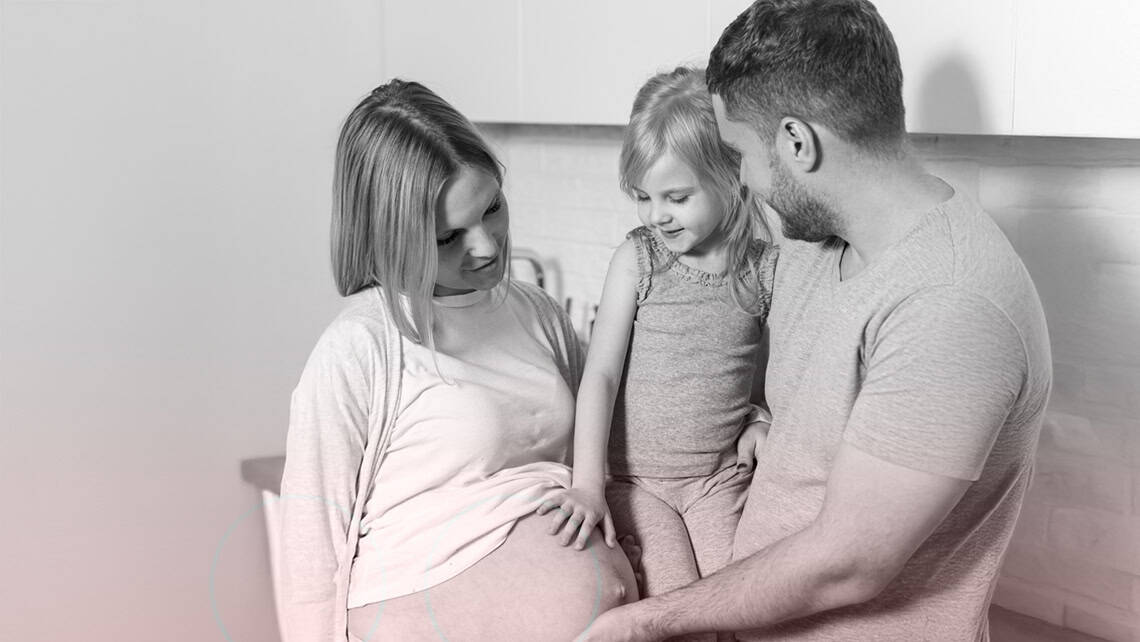
Secondary infertility: causes and treatments
If you already have a child and you want to have another one, but pregnancy does not arrive with natural methods in a reasonable time, we advise you to see a specialist in reproductive medicine to study your case, because you probably have secondary infertility.
Índice
WHAT IS SECONDARY INFERTILITY?
Secondary infertility problems refer to all those alterations appearing after having conceived a child naturally previously.
We speak of secondary sterility when a couple does not achieve a new pregnancy after having had a child previously or secondary infertility when they achieve pregnancy, but this ends in miscarriage after having had offspring previously.
Therefore, we will speak of secondary infertility when, after having conceived a child naturally, the couple does not achieve a new viable gestation (either because they do not get pregnant or because they do, but miscarry), as it appears in ICD-10.
SECONDARY INFERTILITY CAUSES
The causes of secondary infertility are often the same as those of primary infertility (since they share their pathophysiology) although they appear after having given birth to a child.
The most frequent cause, once again, is the age of the couple, and more specifically that of the woman. We are dealing with a couple who probably had their first child without difficulty at a non-so early age (due to the society in which we live) and it is likely that they would like to have a second child when they are over 35-38 years old.
Besides that, there are female causes and also male causes (sometimes mixed), and on other occasions we are unable to determine the cause and this is what we would call secondary infertility of unknown origin.
Causes of female infertility include:
- Tubal alterations: these are anatomical defects of the tubes that prevent them from functioning normally. They are generally due to infectious or inflammatory processes such as pelvic inflammatory disease, infections after an abortion, puerperal infections, endometriosis, hydrosalpinx, etc. They can be diagnosed with complementary tests such as hysterosalpingography, ultrasound or endoscopy.
- Ovarian alterations: these are alterations affecting ovulation or the quality of the egg. They may be organic causes such as endometriosis, inflammation or infection, a tumour… or functional causes such as ovarian insufficiency, alterations in the luteal phase, persistence of the corpus luteum… many of them due to the woman’s age, which is older than when she had her first child.
- Anatomical alterations: in this section we include uterine adhesions, endometrial damage such as polyps or submucous fibroids…
- Alterations in sperm migration: these are vaginal or cervical processes such as infections, inflammations, endometritis, etc. that affect sperm mobility and migration.
- Alterations related to systemic diseases: these are processes that secondarily affect the achievement of pregnancy. These diseases include those related to the thyroid, the adrenal glands, weight alterations (both obesity and extreme thinness), coagulation alterations, the use of drugs, toxins and any serious illness.
As for the causes of male infertility: any disease or process that may affect sperm production and quality. We can include:
- Age: although it is affected later in life, it is also important, especially from the age of 50 onwards.
- Lifestyle: sedentary lifestyle or excessive exercise.
- Surgeries of the uro-genital apparatus.
- Testicular trauma, haematomas, torsion…
- Infections or inflammations: prostatitis, orchitis, epididymitis, STD, varicoceles…
- Tumours.
- Consumption of toxic substances (alcohol, tobacco, anabolic agents, marijuana, cocaine…), chronic use of certain medications (methotrexate, colchicine, sulfasalazine…) or exposure to other toxic substances (herbicides, pesticides…) or radiation.
- Systemic diseases: mumps, diabetes mellitus, multiple sclerosis…
SECONDARY INFERTILITY SOLUTIONS AND TREATMENTS
Treatments for secondary infertility are the same as for primary infertility.
Artificial insemination could be considered for secondary sterility rather than secondary infertility, provided that the patient has permeable fallopian tubes, is young (under 35 years of age) and there is no male factor. It is unlikely that in the search for a second child all these conditions would be met, but it could be considered.
Another option would be to perform in vitro fertilisation (IVF) with or without pre-implantation genetic diagnosis (PGT-A) depending on the patient’s age. As we have said, it is likely that the age of the couple, especially that of the woman, is over 38 years old and that this is the cause of infertility or is a factor added to other causes, this way we can identify chromosomally altered embryos and transfer the chromosomally healthy ones.
The last option would be egg donation in cases where the female’s age is too high or the ovarian reserve has decreased so much that it is impossible to obtain euploid embryos.
In addition, depending on the studies carried out on the male, sperm selection techniques can be applied, if necessary, to obtain better quality embryos.
OVERCOMING SECONDARY INFERTILITY
If you are looking for a second child and you have been trying for more than a year (or more than 6 months if you are over 35) you should consult a specialist in reproductive medicine. This is the first step to overcome this problem, which often has a treatment or a solution.
At the first consultation, a medical history will be registered, paying attention to any changes or alterations that may have appeared and may be the cause of infertility, and you will be asked to undergo the initial tests, which are the same as for primary infertility: an ultrasound scan and a hormone analysis for the woman and a semen analysis for the man.
From here, depending on the diagnostic suspicion, you will be guided through all the complementary tests that you should undergo in order to reach a good diagnosis and thus be able to carry out the appropriate treatment.
REAL EXPERIENCES
I would like to share with you some real cases we have had in our practice:
Clara and Francisco are a couple who came to our clinic when Clara was 38 years old.
They had a 6 year old child and had been looking for their second child for 6 months.
Two years after the birth of her first child, Clara was diagnosed with Crohn’s disease, an inflammatory disease affecting the intestine. She had several episodes of intestinal inflammation and needed surgery on one occasion.
When her digestive doctor managed to stabilise her disease and in accordance with the couple’s wishes, he gave them consent to look for a second child. Clara and Francisco came after 6 months of trying because, with good reason, they suspected that these inflammations had affected her fallopian tubes.
In fact, Clara had a significant abdominal adhesion syndrome and these adhesions had obstructed her tubes. On the other hand, at 38 years of age, she still had a good ovarian reserve, so she underwent IVF-ICSI + PGT-A treatment.
Four blastocysts were obtained, two of which were chromosomally healthy. The first embryo was transferred and she became pregnant.
Today Clara and Francisco have 2 healthy and wonderful children.
A different experience was that of Lucía and Juan. Their medical history only included a first trimester miscarriage that was solved with medical treatment and later, at the age of 33, a spontaneous pregnancy ended in a normal birth with a completely healthy daughter.
At the age of 36 they decided to give her a baby brother and came to our clinic when they had had 3 more miscarriages in their attempt to have a second child.
After an exhaustive study, no organic cause was found in either of them (neither uterine, nor infectious, nor coagulation alterations, nor sperm alterations, nor chromosomal alterations in the parents…) so we advised them to undergo IVF-ICSI+PGT-A treatment. They had 5 blastocysts of which only 1 embryo was euploid. Happily, we achieved pregnancy with this embryo and fulfilled their desire to expand the family.
Dr Judith Moraja (Associated Doctor no. 280605876), gynaecologist specialising in reproductive medicine at Instituto Bernabeu Madrid.
